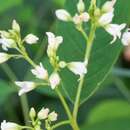Comprehensive Description
provided by North American Flora
Apocynum jonesii Woodson, Ann. Mo. Bot
Gard. 17: 117. 1930.
Stems erect or somewhat ascending, 5-6 dm. tall, the branches opposite, glabrous throughout; leaves petiolate, or the lower subsessile, ascending or only slightly spreading, lanceolateoblong, 3-5 cm, long, 1-2 cm. broad, wholly glabrous; calyx-lobes ovate to ovate-lanceolate, 0.8-1 mm. long, glabrous; corolla urceolate, 2.5-3 mm. long, the lobes erect or ascending, glabrous externally; follicles unknown.
Type locauty: Flagstaff, Arizona. Distribution: Known only from the type locality.
- bibliographic citation
- Robert Everard Woodson, Jr. 1938. (ASCLEPIADALES); APOCYNACEAE. North American flora. vol 29(2). New York Botanical Garden, New York, NY
Comprehensive Description
provided by North American Flora
Apocynum medium Greene, Pittonia 3: 229. 1897
Apocynum speciosum G. Mill. Proc. Biol. Soc. Wash. 13: 83. 1899.
Apocynum urceolifer G. Mill. Proc. Biol. Soc. Wash. 13: 85. 1899.
Apocynum Milleri Britton, Man. 739. 1901.
Apocynum divergens Greene, Leaflets 1: 56. 1904.
Apocynum Andrewsii Greene, Leaflets 1: 57. 1904.
Apocynum sarniense Greene, Leaflets 2: 167. 1912.
Apocynum insigne Greene, Leaflets 2: 178. 1912.
Apocynum ellipHcum Greene, Leaflets 2: 179. 1912.
Apocynum griseum Greene, Leaflets 2: 181. 1912.
Apocynum androsaemi folium var. griseum B€g. & Bel. Mem. Accad. Lincei V. 9: 677. 1913.
Apocynum pumilum var. Milleri B6g. & Bel. Mem. Accad. Lincei V. 9: 686. 1913.
Apocynum macrophyllum B6g. & Bel. Mem. Accad, Lincei V. 9: 713. 1913.
Apocynum pseudomedium B6g. & Bel. Mem. Accad. Lincei V. 9: 714. 1913.
Apocynum Milleri var. pauciflorum Farwell, Rep. Mich. Acad. 17: 170. 1916.
Apocynum medium var. sarniense Woodson, Ann. Mo. Bot. Gard. 17: HI. 1930.
Stems erect or ascending, 2-5 dm. tall, freely and somewhat dichotomously branched, especially below, the branches ascending, alternate to opposite, glabrous to puberulent; leaves opposite, petiolate to subsessile, usually spreading, ovate to oblong-lanceolate, 6-10 cm. long, 1.5-2 cm. broad, occasionally somewhat cordate at the base, glabrous to somewhat puberulent above, more or less pilosulous to tomentulose beneath; calyx-lobes ovate to lanceolate, 1.5-4 mm. long, glabrous to sparsely pilosulous; corolla campanulate to broadly urceolate, 3-6 mm. long, the lobes spreading, white or with pinkish veins; follicles 7-15 cm. long, pendulous at maturity.
Type locawTy: Middle eastern United States [Brookland, D. C.].
Distribution: Newfoundland to Ontario, southward through the eastern United States generally, and westward to Minnesota and New Mexico.
- bibliographic citation
- Robert Everard Woodson, Jr. 1938. (ASCLEPIADALES); APOCYNACEAE. North American flora. vol 29(2). New York Botanical Garden, New York, NY
Apocynum × floribundum: Brief Summary
provided by wikipedia EN
Apocynum × floribundum, the intermediate dogbane, is a member of the family Apocynaceae. It is widespread across Canada, the United States, and northern Mexico.
Intermediate dogbane is believed to be of hybrid origin because its characteristics are intermediate between A. cannabinum (dogbane) and A. androsaemifolium (spreading dogbane).
- license
- cc-by-sa-3.0
- copyright
- Wikipedia authors and editors

